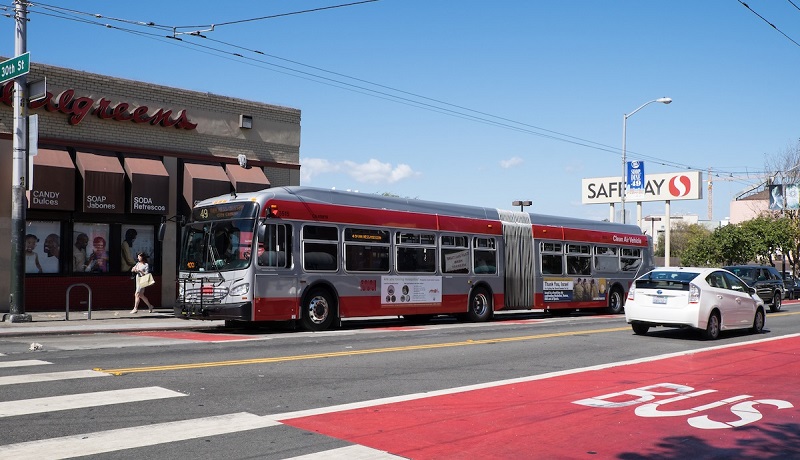
A red transit-only lane on Geary at Jones Street.
It may come as no surprise that using red paint to highlight transit-only lanes causes fewer drivers to violate them, which helps keep them clear to make your Muni trip faster and more reliable. But two new studies have also confirmed that the “red carpet” treatment leads to fewer collisions and risky driving behaviors.
The new findings come from our study on red transit lanes on three downtown streets, and another conducted by the company Zendrive on changes in driving behaviors that resulted from our 14 Mission Rapid Project.
Red transit lanes are a relatively new tool. We’re pioneering them as part of our Muni Forward Rapid Network, which is why the California Traffic Control Devices Committee and the Federal Highway Administration sponsored us to conduct our study on downtown lanes.
SFMTA's Findings on Red Transit Lanes on Three Downtown Streets
In our Red Transit Lanes Final Evaluation Report, we studied red transit lanes that were installed on three streets in 2014:
- 3rd Street, between Townsend and Stevenson streets
- Geary Street, between Powell and Polk streets
- O’Farrell Street, between Gough and Powell streets
Here are some of the key changes we found between 2013 and 2015, after red transit lanes were installed on these streets:
- Muni service was less likely to be delayed traffic congestion. On all three streets, travel times on Muni stayed generally consistent despite increases in car traffic.
- On all three streets, overall collisions dropped by 16 percent, and injury collisions dropped by 24 percent at a time when they did not change significantly citywide.
- Along 3rd Street, the red treatment reduced the number of drivers violating transit lanes by 48 to 55 percent, depending on the time of day – even as the street saw more car traffic.
- Minor collisions involving Muni buses (which disrupt Muni service) decreased along 3rd and Geary, but increased along O’Farrell. The combined total of Muni-involved collisions on all three streets increased by 23 percent, though it increased at the same rate citywide at a time when Muni service and car traffic also increased.

“Red carpet” lanes on Mission at 30th Street.
Zendrive's Findings on Red Transit Lanes on Mission Street
In a related study released last month (and featured today in the SF Examiner), Zendrive focused on the 14 Mission Rapid Project improvements we installed last spring. These included red transit lanes on Mission between 14th and Randall streets.
Zendrive, which “uses the sensors on a smartphone to measure and improve driving behavior,” wrote that the company “examined over 100,000 trips, 7,500 drivers and 1.1 million miles driven [on Mission] from January to October 2016.”
From Zendrive’s blog post:
Zendrive’s study of the safety impacts of the SFMTA’s 14 Mission Rapid project found a demonstrable reduction in risky driving behaviors:
- 36% reduction in speeding
- 30% reduction in fast acceleration
- 21% reduction in hard braking
Early findings show that the project is on course to achieve the SFMTA’s goals of improving the reliability of Muni’s 14R, 14 and 49 [routes], and enhancing safety for everyone walking in the neighborhood.
Those findings appear to be consistent with ours on Mission and other streets. Among the range of findings on the Mission Rapid upgrades we released last August, collisions involving Muni buses dropped by 85 percent, and Muni trips were quicker by an average of two minutes, which means the 67,000 daily trips made on Mission’s bus routes were made easier.
Since we installed our first “red carpet” lane on northern Church Street in 2013, we’ve continued to grow the network (with nine miles to date) and the body of research on them. In doing so, we’re making the case for them to become a new standard so any city can reap their benefits.
Comments are for the English version of this page.